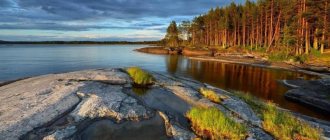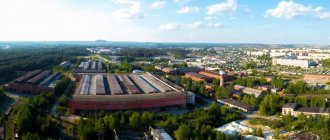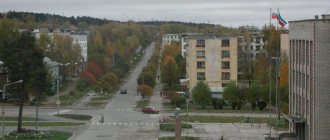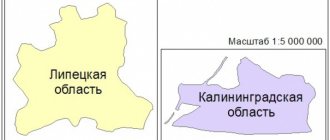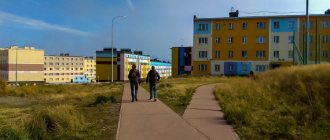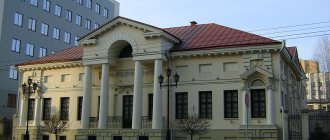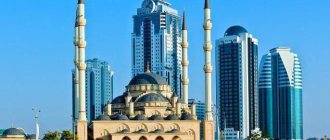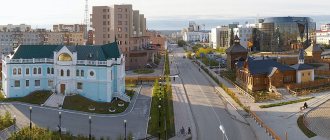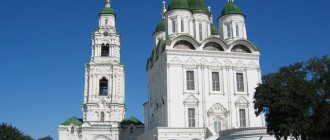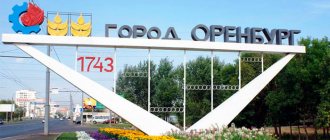Small towns of less than 20 thousand people
Sortavala
Population 18,746 people (2016).
Medvezhyegorsk
Population 14,520 people (2016).
Kem
Population 11,775 people (2016).
Pitkäranta
Population 10,705 people (2016).
Belomorsk
Population 10,052 people (2016).
Suoyarvi
Population 9,076 people (2016).
Pudozh
Population 9,163 people (2016).
Olonets
Population 8,152 people (2016).
Lahdenpokhya
Population 7,493 people (2016).
List of cities in Karelia
There are currently 13 cities in the Republic of Karelia.
11 of them are simultaneously district centers, and two - Petrozavodsk and Kostomuksha - form urban districts. Location: Republic of Karelia. language . Date of creation: the most ancient city of Karelia is Olonets.
General information Edit
The most ancient city in Karelia is Olonets. This name is mentioned both in the postscript to the Charter of the Novgorod prince Svyatoslav Olgovich, dated 1137, and in the chronicles of 12281. The youngest city in the republic is Kostomuksha, it was founded in 1977 thanks to the mining and processing plant built nearby. The largest population lives in the capital of Karelia - Petrozavodsk, about 280 thousand people5. The smallest is in Lakhdenpokhya, about 7 thousand people.
Cities of the Republic of Karelia Edit
Petrozavodsk
The capital of Karelia, its largest city. It is from Petrozavodsk that most Russian tourists begin their acquaintance with the republic. It was founded in the same year as St. Petersburg. On September 1, 1703, on the shores of Lake Onega, by decree of Emperor Peter I, the construction of an arms factory began, which gave rise to the city. But the first settlements in these places date back to the Mesolithic era. Representatives of about 50 nationalities live in Petrozavodsk, Russians predominate among them. Also, 20% of the region’s Karelians live in the capital, and more than half of all Vepsians in Karelia2. On the list of Petrozavodsk attractions that are a must-see, the pride and pearl of the city is its famous embankment. The scientific life of the region is also concentrated here - the flagship university of the republic is Petrozavodsk State University, the State Conservatory named after. A.K. Glazunov, Karelian Scientific Center of the Russian Academy of Sciences and branches of other universities.
Coat of arms of Petrozavodsk
Kondopoga
The second most populous city in Karelia is almost 30 thousand people. The settlement acquired city status in 1938. The city-forming enterprise of Kondopoga is a pulp and paper mill. A half-hour drive away is the Kivach nature reserve, where you can see one of the most famous waterfalls of the republic. The main shrine of Kondopoga - the Assumption Church, dating back to the 18th century - was burned in 2021, the monument is planned to be restored.
Kondopoga on Google map
Kostomuksha
The third largest city in Karelia with a population of 29 thousand people. It arose thanks to the construction of the mining and processing plant, now called Karelian Okatysh. The key figures in this event - Alexey Kosygin and Urho Kekkonen - were erected a monument in Kostomuksha. This is a very green city: it has a visitor center, and one of its trails called “Amazing Nearby”, located near the reserve office, is very popular among citizens. The territory of the Kostomuksha urban district includes the ancient rune-singing village of Voknavolok, one of those places where the runes of the famous Karelian-Finnish epic “Kalevala” were recorded.
Trail in the Kostomuksha Nature Reserve
Sortavala
The population of the city is almost 19 thousand people. One of the most widespread legends about the origin of its name (sortavala - “the power of the devil” (Finnish))6 says that it was here that supposedly evil spirits, expelled by the monks during the consecration of Valaam, landed here. Sortavala is considered the second tourist center of Karelia after Petrozavodsk. Here is one of the starting points of water tourist routes to Valaam; it is included in the international tourist route “Blue Road”, stretching from the coast of Norway to Pudozh - this fact, as well as its proximity to the border with Finland, ensures Sortavala a flow of foreign tourists. Sortavala is called an architectural encyclopedia. In Sortavala there are buildings built in the Empire style, Finnish national romanticism, pseudo-Gothic, neoclassical and functionalism. Its historical center, according to scientists, was formed from the end of the 19th century to the middle of the 20th century.
Olonets
The oldest of all cities in Karelia. Now it is home to a little over 8 thousand people. The centuries-old history of Olonets, dating back to the 12th-13th centuries, also includes times of rise, when a fortress was built at the confluence of Olonka and Megrega to protect the borders from Swedish expansion (the exact date of completion of construction is September 29, 1649); and the heyday, when the city gradually lost its military significance due to the final victory of our weapons over the Swedes, but continued to be the trade center of Karelia, and the province, although its administrative center moved to Petrozavodsk, continued to be called Olonetsk; and times of calm life in a provincial town with a rich cultural heritage. Olonets has preserved the layout of the 18th century. It is interesting that more than half of its population are Karelians; the Olonets National Museum carefully preserves local traditions and customs.
Pudozh
Another ancient city of the republic with a population of 8.7 thousand people. It was first mentioned as the village of Pudoga in sources dating back to 13828. It acquired city status in 1785 by decree of Catherine II. In the center of Pudozh you can still see blocks of historical buildings from the 19th - early 20th centuries. For a long time, Pudozh was a center for the cultivation and trade of flax and linen products, which is reflected in its coat of arms.
Coat of arms of Pudozh
Belomorsk
The population of Belomorsk is approximately 9.5 people. people The official date of formation of the city is 1938, but, as indicated in the Karelia encyclopedia, the first written mentions of the village of Soroka, from which the history of Belomorsk originates, date back to 14199. The very favorable location of the settlement - at the confluence of the navigable Vyg River into the sea, one of the two largest Karelian rivers in the White Sea basin - determined the nature of the activities of the local residents: fishing, hunting, deforestation. An additional impetus for development was given by the commissioning of the White Sea-Baltic Canal (BBK) in 1933. It runs along the path of the famous “Osudareva Road”. Not far from Belomorsk there are world-famous petroglyphs. The traditions and culture of the original ethnographic group of Pomors living in these places are preserved by the White Sea Museum of Local Lore, the Pomeranian Folk Choir, as well as other institutions and folklore groups11.
Kem
Another Pomeranian city with a population of about 11 thousand people. It is located on the Kemi River, near its confluence with the White Sea. Founded in the 14th century. Among the cultural attractions of Kem, tourists may be interested in the Kem Regional History Museum "Pomorie" and the Assumption Cathedral, where the bulk of the restoration work was recently completed.
Medvezhyegorsk
The population is about 14 thousand people. Interesting facts about Medvezhyegorsk:
- It has sister cities - Russian Mozhaisk and Finnish Sotkamo.
- The city has several enterprises for the procurement and processing of wood and the production of crushed stone. The traditions of folk Karelian embroidery are preserved and popularized by the factory for the production of embroidered linen products “Karelian Patterns”.
- In Russia, Medvezhyegorsk is known as the main filming location of the well-known Soviet comedy “Love and Doves”.
- In 2021, Medvezhyegorsk hosted guests of the holiday in honor of the Day of the Republic of Karelia.
Pitkäranta
Pitkäranta – translated into Russian as “long shore” – lies in a narrow strip along Lake Ladoga; with a length of ten kilometers, its width is about one kilometer. About 10 thousand people live here. The history of the city's development began with the metallurgical industry; at the moment, the city-forming enterprise is considered to be the cellulose industry (RK-Grand LLC).
Segezha
A city with a population of 26 thousand people. grew out of a small village, which was developed first thanks to the railroad laid nearby, and then the construction of the Segezha Timber and Paper Mill - now JSC Segezha Pulp and Paper Mill, which began its work in July 1939. Segezha received the status of a city at the end of 1943. The Segezha coat of arms depicts stylized spruce, diverging on two sides into rolls of paper.
Coat of arms of Segezha
Suoyarvi
Located on the coast of Lake Suoyarvi, the population is about 9 thousand people. In the 20th century, the city was for some time part of Finland, which gained independence after the events of the October Revolution. But in 1944 Suoyarvi returned to the USSR. Several memorable places in the city are dedicated to the battles on Karelian soil during the Winter and Second World Wars, for example, a monument erected in honor of the only Ingrian Finn who held the title of Hero of the Soviet Union, Petr Tikiläinen.
Lahdenpokhya
7 thousand people live in the city. In the 16th century, on the site of the future city of Lakhdenpokhya, the village of Yakkima existed; for some time the territory belonged to Sweden under the terms of the Stolbovo Peace Treaty, but after the Northern War it again became part of the Russian Empire, so that after the revolution and the proclamation of the independence of Finland it would now become Finnish territory. Lahdenpokhya became part of the USSR after the Soviet-Finnish War of 1939-41. The Finns returned to these territories during the Great Patriotic War, but in 1944 Lahdenpohja again became a Soviet city. Today Lakhdenpokhya is included in the list of single-industry towns in Russia; a bakery and a timber industry enterprise operate on the territory of the city.
see also
- Karelia
- Cities of Russia
| [ + ] Cities by regions of Russia | |
| Cities of the North-West (NWFD) | St. Petersburg (and its cities) • Leningrad region (historical Staraya Ladoga) • Arkhangelsk region • Vologda region • Kaliningrad region • Karelia • Komi • Murmansk region • Nenets Autonomous Okrug • Pskov region |
| Cities of the Volga region (Volga Federal District) | Bashkortostan • Volgograd region • Kalmykia • Kirov region • Mari El • Mordovia • Nizhny Novgorod region • Orenburg region • Penza region • Perm region • Samara region • Saratov region • Tatarstan • Udmurtia • Ulyanovsk region • Chuvashia |
| Cities of Southern Russia (SFD) | Sevastopol (including Inkerman) • Republic of Crimea • Adygea • Astrakhan region • Krasnodar region • Rostov region |
| Cities of the North Caucasus (NCFD) | Dagestan • Ingushetia • Kabardino-Balkaria • Karachay-Cherkessia • North Ossetia - Alania • Stavropol Territory • Chechen Republic |
| Cities of the Urals (Ural Federal District) | Kurgan region • Sverdlovsk region • Tyumen region • Khanty-Mansi Autonomous Okrug - Yugra • Chelyabinsk region • Yamalo-Nenets Autonomous Okrug |
| Cities of Siberia (Siberian Federal District) | Altai Republic • Altai Territory • Irkutsk Region • Kemerovo Region • Krasnoyarsk Region • Novgorod Region • Novosibirsk Region • Omsk Region • Tomsk Region • Tyva • Khakassia |
| Cities of the Far East (FEFD) | Amur Region • Buryatia • Jewish Autonomous Region • Trans-Baikal Territory • Kamchatka Territory • Magadan Region • Primorsky Territory • Sakha (Yakutia) • Sakhalin Region • Khabarovsk Territory • Chukotka Autonomous Region |
| see also | Cities of the DPR, LPR, Transnistria, South Ossetia • Regions of Russia • Cities of Russia |
Geography
The main relief of the republic is a hilly plain, turning in the west into the Western Karelian Upland. The glacier, retreating to the north, greatly changed the topography of Karelia - moraine ridges, eskers, kamas, and lake basins appeared in abundance. The highest point of the Republic of Karelia is Mount Nuorunen. The weather is changeable.
The climate is mild with plenty of precipitation, changing on the territory of Karelia from marine to temperate continental. Winter is snowy, cool, but usually without severe frosts; if frosts occur, it is only for a few days. Summers are short and warm, with high rainfall. Rarely, but frosts still occur. The heat sets in for two to three weeks in the southern regions, but due to the high humidity it is noticeable even at +20°C. In the northern parts, the heat is extremely rare and lasts no more than a few days.
Rent a Car
For those traveling without their own car, but wanting to explore the region, it makes sense to rent a car. In Petrozavodsk there are several local companies; in other cities, most likely, you will have to negotiate with private individuals, and the service will be complex: “car + driver”.
Rental costs from 1,500 RUB per day, in most cases you will have to leave a deposit for the car. To rent, you will need a passport and driver's license, driving experience must be at least two years, and the driver must be at least 21 years old. Although some companies make concessions. The car is issued with a full tank of gasoline, and must be returned in the same condition.
When choosing a car, you should take into account your plans: it is better to take an SUV, since there are very difficult places in Karelia. It’s worth taking care of the car in advance and making arrangements from home to choose the right model.
Cuisine and restaurants of Karelia
Karelian cuisine is closely intertwined with the nature of the region. Local residents have been engaged in fishing and berry picking for a long time; these products occupy a special place on the table. Pies with fish, mushrooms, peas and turnips are very popular. The most commonly used vegetables are turnips, radishes, and green onions. Veal with vegetables in pots is called meat in Petrovsky style. But the most famous dishes are Karelian “kalitki” - a special type of open pies in the shape of a boat with filling, and “kalaruoka” - an unusual fish soup that is boiled in milk and sometimes passed through a layer of birch charcoal.
The most favorite berries are lingonberries and cranberries; since ancient times they have been prepared for the winter and added to the same pies. Raspberries and blueberries are especially popular as medicines.
It is interesting that blueberries, which grow in abundance in the swamps of Karelia, were not eaten before; it was believed that they were dangerous and caused headaches.
Nowadays, it is not so easy to come across Karelian restaurants, although in Petro, which positions itself as the first and only restaurant of national cuisine in the world. In general, there will be no problems finding a place for lunch in the region. In canteens and refectories you can eat for 400-500 RUB per person; numerous cafes offer lunch for about 600 RUB. And in expensive restaurants, dinner will cost about 1500-2000 RUB per person, excluding alcoholic beverages. Fast food is represented only by large chain establishments.
Urban settlements[ | ]
| № | Name | district/city of republican significance[5] | mun. district / urban district[6] | population (persons) | founding/first mention | town status | coat of arms | former names |
| 1 | Värtsilä (Finnish: Värtsilä ) | Sortavala | Sortavala municipal district | ↘2916[4] | 1499 | 1946 | ||
| 2 | Kalevala (Karelian Kalevala ) | Kalevalsky district | Kalevalsky municipal district | ↘3784[4] | 1552 | 1963 | Ukhta (until 1963) | |
| 3 | Louhi (Karelian Louhi ) | Loukhi district | Louhi municipal district | ↘3749[4] | 1913 | 1944 | ||
| 4 | Muezersky (Karelian: Mujehdjärvi) | Muezersky district | Muezersky municipal district | ↘2673[4] | 16th century | 1965 | Muezero | |
| 5 | Nadvoitsy (Finnish: Vojatsu ) | Segezha district | Segezha municipal district | ↘7136[4] | 1620 | 1942 | Warriors | |
| 6 | Pindushi (Karelian Pinduši) | Medvezhyegorsky district | Medvezhyegorsky municipal district | ↘4193[4] | 1933 | 1950 | ||
| 7 | Povenets (Karelian Poventsa ) | Medvezhyegorsky district | Medvezhyegorsky municipal district | ↘1711[4] | 15th century | 1938 | Povenets Row (until 1782) | |
| 8 | Yarn (Karelian Priäžä) | Pryazhinsky district | Pryazhinsky municipal district | ↘3438[4] | 1650 | 1962 | ||
| 9 | Pyaozersky (Karelian Pääjärvi) | Loukhi district | Louhi municipal district | ↘1564[4] | 1973 | 1976 | ||
| 10 | Helyulya (Finnish: Helylä ) | Sortavala | Sortavala municipal district | ↘2369[4] | 1500 | 1972 | ||
| 11 | Chupa (Karelian Čuuppu ) | Loukhi district | Louhi municipal district | ↘2150[4] | 1574 | 1943 |
Settlements that have lost the status of an urban-type settlement[ | ]
Main article: Former urban-type settlements of Karelia
Cities[ | ]
| № | Name | district/city of republican significance[5] | mun. district / urban district[6] | population (persons) | founding/first mention | city status | coat of arms | former names |
| 1 | Belomorsk (Karelian Šuomua) | Belomorsky district | Belomorsky municipal district | ↘9036[4] | 1419 | 1938 | Soroka (until 1938) | |
| 2 | Kem (Karelian Kemi ) | Kemsky district | Kem municipal district | ↘10 463[4] | XIV century | 1785 | ||
| 3 | Kondopoga (Karelian Kondupohju) | Kondopoga district | Kondopoga municipal district | ↘28 744[4] | 1563 | 1938 | ||
| 4 | Kostomuksha (Karelian Koštamuš) | Kostomuksha | Kostomuksha GO | ↗29 778[4] | 1977 | 1983 | ||
| 5 | Lahdenpohja (Finnish: Lahdenpohja ) | Lakhdenpokh district | Lakhdenpokhsky municipal district | ↘6890[4] | 1600 | 1945 | Yakimvara Station , Yakimvara (until 1918) | |
| 6 | Medvezhyegorsk (Karelian Karhumägi) | Medvezhyegorsky district | Medvezhyegorsky municipal district | ↘13 841[4] | 1916 | 1938 | Bear Mountain (until 1938) | |
| 7 | Olonets (Karelian Anuksenlinnu) | Olonetsky district | Olonetsky municipal district | ↘7942[4] | 1137 | 1649 | ||
| 8 | Petrozavodsk (Karelian Petroskoi) | Petrozavodsk | Petrozavodsk GO | ↘280 711[4] | 1703 | 1777 | Shuisky Factory (1703-1704) Petrovskaya Sloboda (1704-1744) | |
| 9 | Pitkyaranta (Karelian Pitkyrandu) | Pitkyaranta district | Pitkyaranta municipal district | ↘10 048[4] | 1499 | 1940 | Village on the Long Shore , Pitkerando | |
| 10 | Pudozh (Karelian Puudoži) | Pudozhsky district | Pudozh municipal district | ↘8513[4] | 1382 | 1785 | ||
| 11 | Segezha (Karelian Segeža) | Segezha district | Segezha municipal district | ↘25 585[4] | 1914 | 1943 | ||
| 12 | Sortavala (Karelian Sortavala) | Sortavala | Sortavala municipal district | ↘18 704[4] | 1468 | 1783 | Serdobol (until 1918) | |
| 13 | Suojärvi (Karelian Suojärvi) | Suoyarvi district | Suoyarvi municipal district | ↘8607[4] | 16th century | 1940 | Shuezersk |
Settlements that have lost their city status[ | ]
Preserved, but lost city status:
- Padansk is now the village of Padany. The city from 1777 to 1782.
- Povenets - now the town. The city from 1777 to 1927.
What to bring
Travelers from Karelia bring items made from natural materials as souvenirs. The most popular of them is Karelian birch. A lot of souvenirs are made from this beautiful wood - from key rings to boxes and watches. The wood gives an unusual pattern and color in the decoration: dark brown stains stand out fancifully against a soft yellow background. Shungite products are also brought from here. A black stone with a characteristic metallic luster and healing properties is used to make bracelets, rosaries, beads, balls and pyramids. In addition, it is included in special creams that help with diseases of the musculoskeletal system.
Karelian herbal balsam and various tinctures of local berries will be a good gift for relatives. And also jams made from northern berries: cloudberries, lingonberries, cranberries and serviceberries.
If you shop at a supermarket rather than a souvenir shop, you can save a lot of money.
Many are fascinated by Zaonezh embroidery: simple and picturesque red patterns on undyed linen. The most practical gifts are towels, napkins, tablecloths and potholders.
